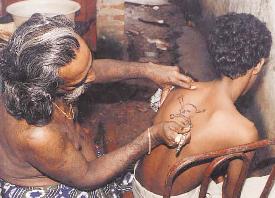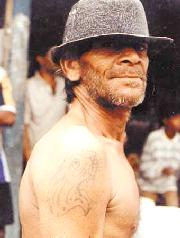



![]()
Tattoos, are believed to have originated in China 5000 years ago. Tattooing is a way of inserting pigments into the skin by piercing it with pointed needle........Arshad M. Hadjirin and Chamintha Tilakaratna hit the streets of Thotalanga in search of these extraordinary artists
Many years ago, if you fancied getting a tattoo done, you would probably
have been directed to the streets of Thotalanga,  which
were at a time one of the most prominent places associated with this fad.
Here you could get a tattoo done on your forearms, face, legs, or on any
less visible part of your anatomy. But today though a walk down these narrow
streets might reveal some men sporting tattoos all over their bodies, the
tattoo artists themselves are less easy to find.
which
were at a time one of the most prominent places associated with this fad.
Here you could get a tattoo done on your forearms, face, legs, or on any
less visible part of your anatomy. But today though a walk down these narrow
streets might reveal some men sporting tattoos all over their bodies, the
tattoo artists themselves are less easy to find.
With the advent of sophisticated systems of painting a tattoo, which could be erased and replaced with a new design, it is only too natural for the younger generation to ignore the old system of permanent tattooing. This modern western method of tattooing has not penetrated our culture,but a large number of students, tourists, and even young women still go in search of the tattoo artists to get their bodies tattooed for good.
Tattoos, are believed to have originated in China 5000 years back. Tattooing is a way of inserting pigments into the skin by piercing it with pointed needle like equipment. And what was once a habit of olden days is now fast taking on the guise of a fashion statement in the West.
In our quest for a tattoo maker we came across many people at Thotalanga, who had massive patches of designs on their skins in green, red, and yellow. Joseph Pelpt, one of them introduced a number of others with tattoos, all from the older generation.
Pelpt who had been working at the Thotalanga market ever since he can remember said that he initially got a tattoo done because he had developed rheumatism at his youth in the nineteen fifties. Pelpt like so many others had believed that tattooing was a well known cure for his rheumatism. He has a colourful tattoo of the sun rising behind a cross done in black, red and yellow on his arm.
But many who have got tattoos done said they did so as tattooing was in vogue at the time and almost everybody who was somebody had one. “It was not only the ‘chandiyas’ ( tough men) who got them done,” Pelpt said. Having a tattoo made a person stand out in a crowd, they believed.
Some are in the habit of getting themselves tattooed to get over their personal frustrations and disappointments. “Some of the people who arrive to get tattoos done are either after a few drinks or after an emotional quarrel with their lovers,” Pelpt said.
It was believed that the Indian-Ink which the tattoo artist uses contained medicines which the body absorbs and that the method in which it is applied helps cure rheumatism. Rheumatism being an illness which concerns the nerves, the presumed medicine is applied with the movement of pricking the skin and the nerves with a needle, like that of acupuncture, the only difference being that in acupuncture there is no medicine involved, only needles.
The method of tattooing is simple but requires a lot of patience and
time. The Sunday Times managed to reach Bernard, who is better known as
‘Pachcha Sira’ who claims that he is the only remaining tattoo artist in
Colombo. According to him there are  only
two others existing in the same profession who are at Anuradhapura and
Halawatha.(Chilaw)
only
two others existing in the same profession who are at Anuradhapura and
Halawatha.(Chilaw)
Getting your skin tattooed is a painful experience, but nevertheless it is considered to be fun on the part of the tattooee. The tattoo maker or the artist generally gets down to business by asking his customer, what type of design he or she would prefer. Dragons, snakes, eagles and other similar figures were some of the designs, favoured in the past.
“I wanted to get a unique design for both myself and my girl-friend, as a mark of remembrance,” Romesh Costa, a 27 year-old business executive said. Similarly, according to ‘Pachcha Sira’ most of his young customers ask him to draw new designs so that it could be unique, but most often they are the initials of their lovers .
After finalising the design, the tattoo maker needs his tools. First the design is drawn on the skin as clearly and discreetly as possible with the ink which comes in four different colours namely black, red, yellow and blue. After the design is spread on the skin, an instrument similar to a drawing nib is used for pricking the lines of the design, using corresponding inks.
However skilful and professional the pricking may seem to be, blood seeps through the fine gashes made on the skin. “It is through these cuts that the Indian ink is applied,” said Pachcha Sira while demonstrating his technique on a hurriedly drawn skull and bones design on the back of one of his customers.
Once the blood dries out, the Indian-Ink firmly sets into these gashes. Within a few weeks time the bruises also completely heal out and then, out comes the tattoo bright and clear in all its vibrant colours. According to Pachcha Sira, there are no after effects as a result of tattooing and the needles are sterilised before use.
If one wants the tattoo removed, then either the tattooee can patch it up with another design or colour the entire design in black, or get it removed through another complicated procedure, which is as painful. But either way, a mark will be left on the body. If the tattoo is removed there will be a scar on the body, while if it is over painted with another or the same colour, then there will be a colour patch.
But renowned skin specialist Dr.D.N. Atukorala, talking to ‘The Sunday Times’ about the after effects of tattooing clearly stated, that tattooing has no bearing whatsoever in curing any illness and that instead it has several harmful side-effects.
“Tattooing causes infections to begin with,” said Dr.Athukorale. “In many cases if not all, the needles, ink, or some other substance, may be contaminated; it therefore could be highly dangerous with several sexually transmitted diseases on the spread,” he said.
Secondly, he said that introducing a foreign substance - the Indian-Ink, in this case - into the human body will certainly cause side effects. Dermatitis, Dr. Athukorale said, is a disease one could get as a result. “Besides one could even become hyper sensitive,” he said explaining that generally the side effects of tattooing appear long after getting the tattoo done.
Finally Dr. Athukorale said that once done a tattoo is always a tattoo, and erasing it completely is virtually impossible. He said that with the modern day laser technology one could erase a tattoo to a certain extent. But with criticism about the harmful effects of using lasers on the skin, gaining access to such treatment, has become rare.
The cost of getting a tattoo is not cheap either. It costs about Rs.300 for an average size tattoo and the standard rate according to Pachcha Sira is that of Rs. 25 per letter. Removing it would cost around Rs.750 at the least.
Reginald Pelpt, the brother of Joseph who has a very unique tattoo of a ship on his chest, said that it is a very long time since he saw anyone doing a tattoo. “It is a dying profession, and youngsters don’t seem to take up this challenge,” lamented another by the name of Sadha, who had massive tattoos on his body
Modern-day techniques of tattooing are certainly becoming very innovative, and in the west these could be erased as well. Sometimes the tattoos are applied like a sticker. But in Sri Lanka, the few remaining tattoo artists still hold sway.
Continue to Mirror Magazine page 4 * A close call over the Taiga * The Bird of Prey * Man -made Materials
Return to Mirror Magazine contents
![]()
Please send your comments and suggestions on this web site to
info@suntimes.is.lk or to
webmaster@infolabs.is.lk